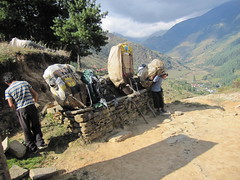I’m in the process of writing an entry about bonded (child) labors in the Tarai area, where the Tharus indigenous people live, but then I consider why don’t give a more general view on child labor in Nepal before it. So, as an introduction to bonded (child) labors in Tarai area I post this entry.
Child Labor in Numbers:
*Statistics shows that of about 7 million children between 5-14 years old working in Nepal, about 3 million are found to be regularly working and 1.7 million children are found to be economically active.
*Almost two fifths children of school-going age are economically active.
*The number of child laborers is estimated at around 2,060,000 where about, 94.7% are involved in agriculture and household work and the remaining 5% are engaged in service and manufacturing industries. For every 100 children in the 6-14 years age group, 4-5 are engaged in paid work.
*CWCD in 1998 found that 71% of rural, 52% of urban and 63% of Kamaiya children are economically active.
*According to the ILO-sponsored national survey, of the 6.2 million children between the ages of 5-14 years, 2,596,000 are child workers, which forms 41.7% of this age group.
*Of 2.59 million working children, 278,000 or 4.5% of all Nepali children are in paid work and 1.38 million or 22.2% of all children are in unpaid work.
Worst Forms of Child Labor in Numbers:
This part shows statistical data on some types of child labor which categorized as the worst forms of child labor by ILO.
Note: As I mentioned in my earlier entry, Kamaiya system is one of the bonded labor system, generally in the agriculture sector, in Nepal. The people, usually the whole family, which employed under this system have to work to pay off debts incurred by their ancestors. Working condition under this system is far from decent.
*The number of bonded children is estimated at 33,000.
*40,000 children are estimated to be in debt-bondage.
*40,000 Nepalese girls under 16 in Indian brothels are forced into prostitution
*More than 9,000 girls are trafficked each year from Nepal and Bangladesh into bondage in India and Pakistan, often with the acquiescence or cooperation of state officials
*It is estimated that at least 1 million children in Nepal are working as child laborers in difficult circumstances, often as slaves in carpet factories, brick kilns, domestic service, agriculture, plantation, construction, transportation, stone quarry, mines and as migrant workers.
*Available data suggests that approximately 7,000 girls between 10 -18 are lured or abducted into prostitution each year. In many cases, parents or relatives sell young girls into sexual slavery
*Among the Kamaiya families the number of children working under the system is reported to be about 13,000.
(Source: http://www.globalmarch.org/worstformsreport/world/nepal.html )
Posted By Maelanny Purwaningrum
Posted May 5th, 2011


